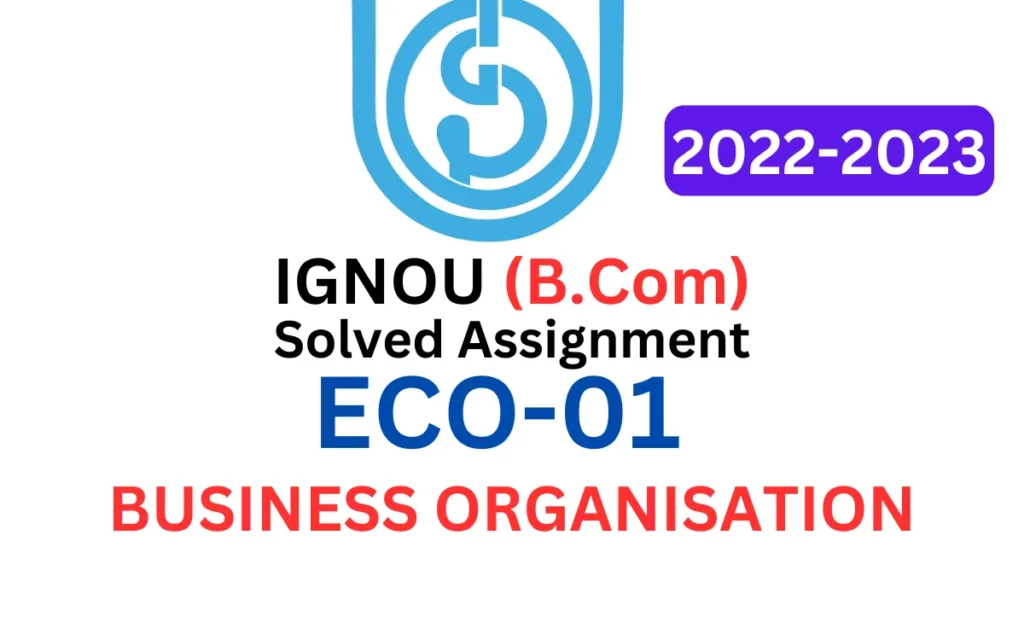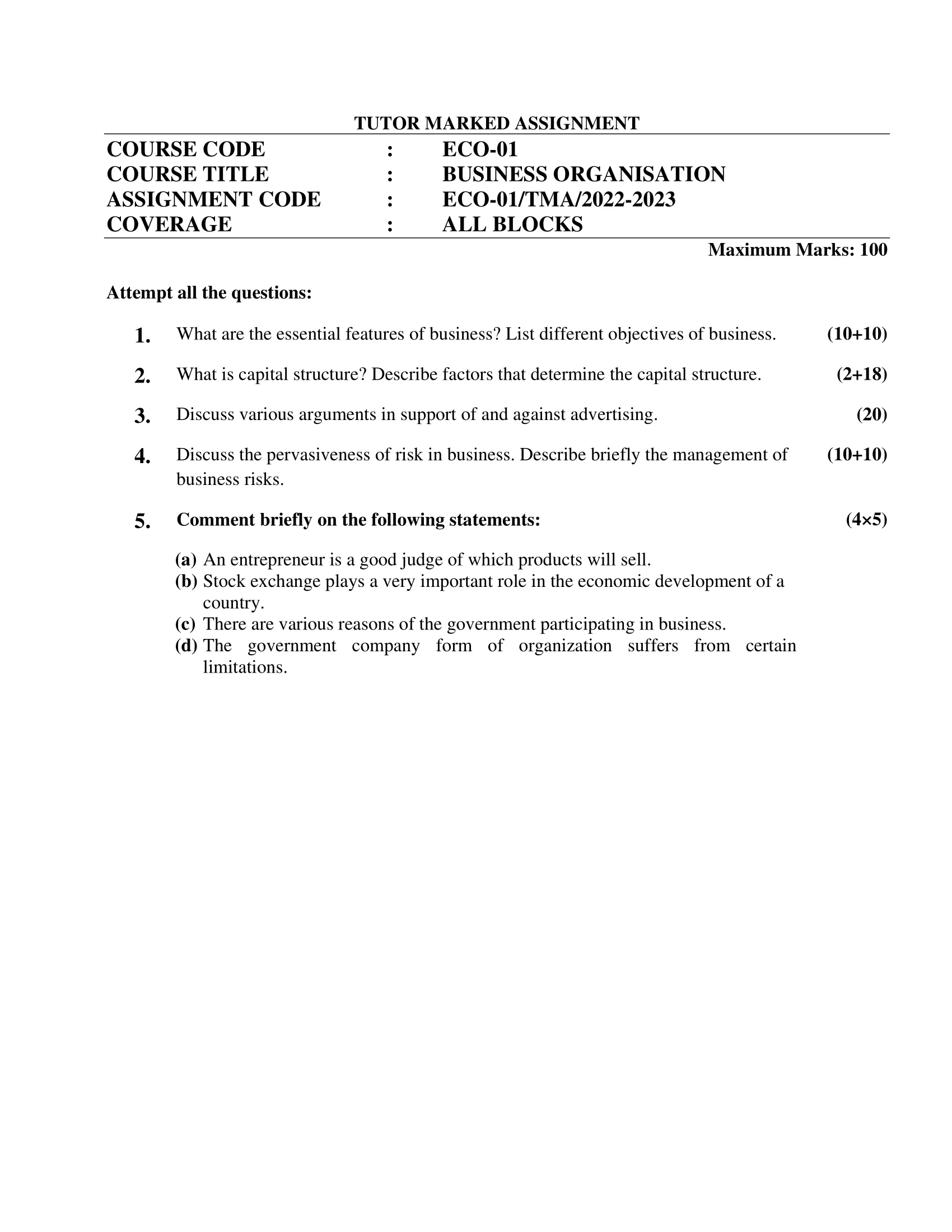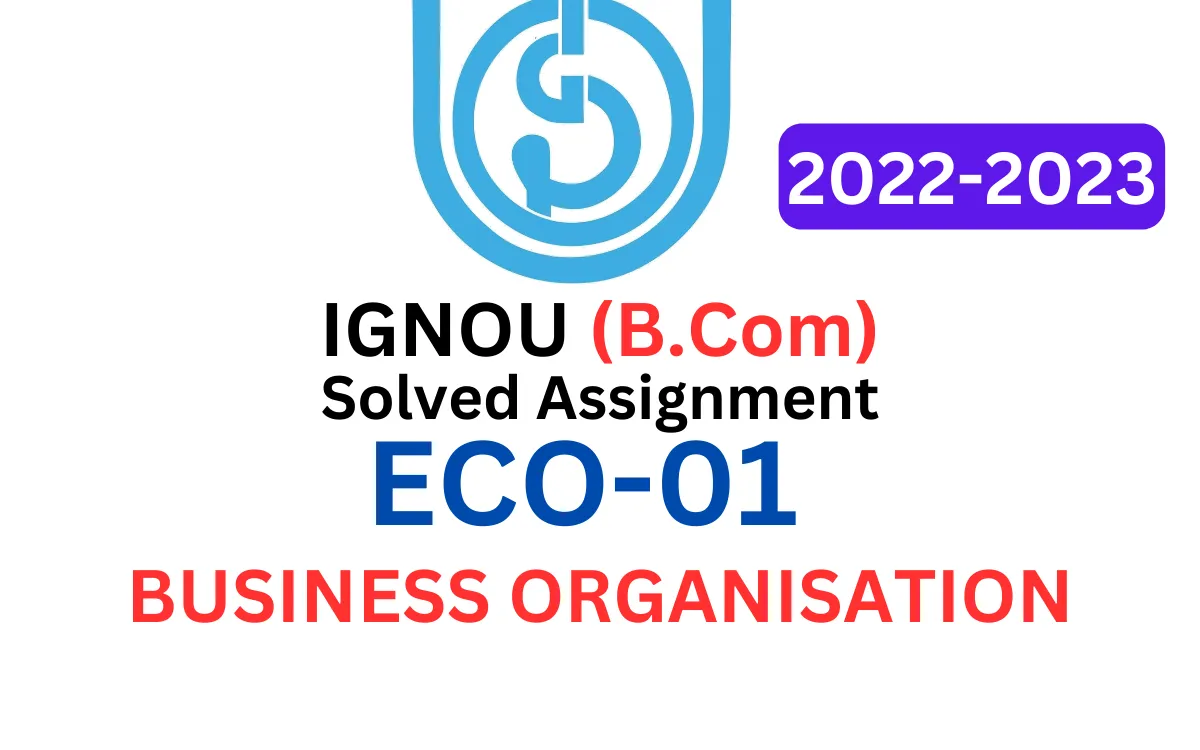
| Title | ECO-01: IGNOU B.Com Solved Assignment 2022-2023 |
| University | IGNOU |
| Degree | Bachelor Degree Programme |
| Course Code | ECO-01 |
| Course Name | BUSINESS ORGANISATION |
| Programme Name | B.Com |
| Programme Code | BDP |
| Total Marks | 100 |
| Year | 2022-2023 |
| Language | English |
| Assignment Code | ECO-01/TMA/2022-2023 |
| Assignment PDF | Click Here |
| Last Date for Submission of Assignment: | For June Examination: 31st April For December Examination: 30th September |

1. What are the essential features of business? List different objectives of business.
Ans: The essential features of business include:
- Economic activity: Business involves the production and distribution of goods and services with the aim of earning a profit.
- Exchange of goods and services: Business involves the exchange of goods and services between buyers and sellers.
- Profit motive: The primary objective of a business is to earn a profit.
- Risk and uncertainty: Business involves taking risks and dealing with uncertainty in order to make a profit.
- Continuous process: Business is a continuous process that involves various activities like production, marketing, sales, and distribution.
- Legal entity: A business is a legal entity that is recognized by law and has a separate existence from its owners.
Some of the objectives of business are:
- Profit maximization: The main objective of most businesses is to maximize their profits by increasing sales and minimizing costs.
- Growth and expansion: Many businesses aim to grow and expand their operations by increasing their market share, adding new products or services, or expanding into new markets.
- Customer satisfaction: Businesses may aim to satisfy their customers by providing quality products and services, improving customer service, and offering competitive prices.
- Social responsibility: Some businesses may aim to fulfill their social responsibility by engaging in activities that benefit society, such as charitable donations, environmental conservation, or ethical business practices.
- Employee satisfaction: Businesses may aim to provide a satisfying work environment for their employees by offering good working conditions, competitive salaries, and opportunities for career development.
- Innovation: Some businesses may aim to innovate by developing new products, services, or technologies to stay competitive and meet the changing needs of their customers.
2. What is capital structure? Describe factors that determine the capital structure.
Ans: Capital structure refers to the way a company finances its operations and growth by using a combination of debt and equity. In other words, it is the mix of debt and equity that a company uses to fund its operations and investments.
The factors that determine a company’s capital structure are:
- Business risk: The level of risk associated with a company’s operations can influence its capital structure. Companies with high business risk may prefer to use less debt to avoid the risk of default and bankruptcy.
- Financial risk: The level of financial risk associated with a company’s operations can also influence its capital structure. Companies with a high level of financial risk may prefer to use less debt to avoid the risk of default and bankruptcy.
- Cost of capital: The cost of capital is the cost of financing a company’s operations and investments. A company’s capital structure should be designed to minimize its cost of capital.
- Tax environment: The tax environment can also influence a company’s capital structure. Debt is usually tax-deductible, which means that companies can reduce their tax liability by using debt financing.
- Market conditions: The availability and cost of debt and equity financing can be influenced by market conditions. For example, during periods of economic growth, interest rates may be low, making debt financing more attractive.
- Industry norms: The capital structure of a company may also be influenced by industry norms. For example, companies in certain industries, such as utilities or real estate, may have higher levels of debt than companies in other industries.
- Management preferences: Finally, a company’s capital structure may also be influenced by management preferences. Some managers may prefer to use more debt financing to increase leverage and potentially increase returns to shareholders, while others may prefer to use more equity financing to reduce financial risk.
3. Discuss various arguments in support of and against advertising.
Ans: Advertising is a form of communication that promotes products, services, or ideas with the aim of persuading people to buy or use them. There are several arguments both in support of and against advertising.
Arguments in support of advertising:
- Economic benefits: Advertising can have significant economic benefits by creating demand for products and services, which can lead to increased sales and profits for businesses. This, in turn, can lead to job creation and economic growth.
- Information provision: Advertising provides information about products and services to consumers, helping them make informed purchasing decisions. By providing information about the features, benefits, and pricing of products, advertising enables consumers to compare products and make informed choices.
- Brand building: Advertising can help build brand awareness and loyalty, which can be a significant competitive advantage for businesses. By creating a positive brand image, advertising can help businesses differentiate themselves from their competitors and attract loyal customers.
- Supports media: Advertising revenue supports the media industry, which provides valuable news and entertainment content to consumers. Without advertising revenue, many media outlets would not be financially viable and may cease to exist.
Arguments against advertising:
- Manipulation: Critics argue that advertising is manipulative and can exploit consumers by creating false or exaggerated claims about products and services. They also suggest that advertising can create artificial desires for products and services, leading consumers to make irrational purchasing decisions.
- Consumerism: Advertising promotes consumerism by encouraging people to buy more products and services, leading to overconsumption and waste. This, in turn, can lead to negative environmental and social impacts, such as resource depletion and pollution.
- Intrusion: Advertising can be intrusive and annoying, disrupting people’s daily lives and activities. This is particularly true of online advertising, which can be difficult to avoid and can create privacy concerns.
- Cost: Advertising can be costly, and these costs are often passed on to consumers in the form of higher prices. This can be particularly true in industries with high levels of advertising, such as the pharmaceutical and consumer goods industries.
- Stereotypes: Advertising can reinforce gender, racial, and other stereotypes, perpetuating harmful attitudes and behaviors in society.
4. Discuss the pervasiveness of risk in business. Describe briefly the management of business risks.
Ans: Risk is inherent in all businesses, and managing it effectively is critical for their success. Business risks can arise from various sources, including economic, financial, operational, legal, regulatory, and environmental factors. The pervasiveness of risk in business means that businesses need to have a risk management process in place to identify, assess, mitigate, and monitor risks.
The management of business risks involves several steps, including:
- Risk identification: The first step in managing business risks is to identify all the potential risks that the business may face. This can be done through various methods, such as risk assessments, interviews with key personnel, and analyzing historical data.
- Risk assessment: Once the risks have been identified, they need to be assessed in terms of their likelihood and potential impact on the business. This can be done using various tools, such as risk matrices and probability analysis.
- Risk mitigation: After the risks have been assessed, the next step is to develop and implement strategies to mitigate or minimize the risks. This can involve developing risk mitigation plans, implementing control measures, and transferring risk through insurance or other means.
- Risk monitoring: Risk monitoring involves regularly reviewing and updating the risk management process to ensure that it remains effective. This can involve monitoring risk indicators, conducting regular risk assessments, and making changes to the risk management strategy as necessary.
Effective risk management can help businesses avoid or mitigate the negative impacts of risks and take advantage of opportunities. It can also help businesses meet regulatory requirements and maintain the confidence of stakeholders, such as investors, customers, and employees. However, risk management can be challenging and requires a structured and disciplined approach. Therefore, businesses need to have a dedicated risk management function or work with external consultants to manage their risks effectively.
5. Comment briefly on the following statements:
(a) An entrepreneur is a good judge of which products will sell.
Ans: The statement suggests that being an entrepreneur automatically makes one a good judge of which products will sell. However, while entrepreneurship often involves identifying market opportunities and developing innovative products or services, being a good judge of which products will sell requires a deep understanding of customer needs, preferences, and behavior, as well as market trends and competitive dynamics. While some entrepreneurs may have this expertise, others may lack it and could benefit from market research or consulting with industry experts before launching a new product. Therefore, while being an entrepreneur can certainly involve being able to identify products that will sell well, it is not a guarantee that all entrepreneurs possess this skill.
(b) Stock exchange plays a very important role in the economic development of a country.
Ans: The statement is generally true. A stock exchange provides a platform for companies to raise capital by issuing and selling shares of ownership to the public. This, in turn, can stimulate investment, entrepreneurship, and economic growth by providing companies with the resources needed to expand their operations, create jobs, and develop new products and services.
Furthermore, the stock exchange can also provide liquidity to investors, allowing them to buy and sell shares easily and efficiently. This helps to ensure that investors can quickly and easily convert their investments into cash if needed, which can help to boost confidence in the market and attract more investment.
In addition, the stock exchange can also serve as a barometer of the overall health of the economy. The performance of the stock market can provide insights into the current state of the economy, and fluctuations in stock prices can signal changes in investor sentiment, which can in turn affect consumer spending, business investment, and other economic factors.
(c) There are various reasons of the government participating in business.
Ans: Yes, there are various reasons why a government may choose to participate in business activities. Some of these reasons include:
- To promote economic development: The government may participate in business activities to stimulate economic growth and development. This can be achieved by investing in strategic sectors such as infrastructure, healthcare, education, and technology.
- To generate revenue: Governments can participate in business activities to generate revenue through the sale of goods and services. This can help to finance public services and infrastructure projects.
- To protect national interests: The government may participate in business activities to protect national interests, such as ensuring the security of essential supplies or promoting local industries.
- To regulate industries: Governments may participate in business activities to regulate industries and promote fair competition. For example, a government may establish a state-owned enterprise to provide a counterbalance to private companies in a certain industry.
- To create employment: The government may participate in business activities to create employment opportunities, particularly in areas where there may be a shortage of private investment.
- To address market failures: In some cases, the government may participate in business activities to address market failures, such as by providing essential services that may not be profitable for private companies to provide.
(d) The government company form of organization suffers from certain limitations.
Ans: Yes, the government company form of organization does suffer from certain limitations. Some of these limitations include:
- Bureaucratic inefficiencies: Government companies are often criticized for being bureaucratic and inefficient. The decision-making process may be slow and cumbersome, and there may be a lack of accountability and transparency in the management of the company.
- Political interference: There is often a risk of political interference in the management of government companies, which can compromise the independence and objectivity of the company. This can lead to decisions that are motivated by political considerations rather than commercial considerations.
- Lack of flexibility: Government companies may lack the flexibility and agility of private companies, which can make it difficult for them to respond quickly to changes in the market or to innovate.
- Lack of competitiveness: Government companies may struggle to compete with private companies, which may have more resources, better management practices, and greater incentives to succeed in the marketplace.
- Fiscal burden: Government companies may be a fiscal burden on the government, especially if they are not profitable or if they require constant subsidies and support to stay afloat.
How to Download ECO-01 Solved Assignment?
You can download it from the www.edukar.in, they have a big database for all the IGNOU solved assignments.
Is the ECO-01 Solved Assignment Free?
Yes this is absolutely free to download the solved assignment from www.edukar.in
What is the last submission date for ECO-01 Solved Assignment?
For June Examination: 31st April, For December Examination: 30th October




